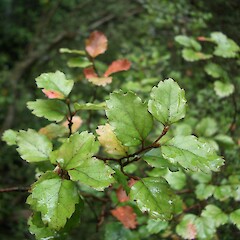Fuscospora fusca
Common name
red beech
Synonyms
Fagus fusca Hook. f., Nothofagus fusca (Hook.f.) Oerst.
Family
Nothofagaceae
Flora category
Vascular – Native
Endemic taxon
Yes
Endemic genus
No
Endemic family
No
Structural class
Trees & Shrubs - Dicotyledons
NVS code
The National Vegetation Survey (NVS) Databank is a physical archive and electronic databank containing records of over 94,000 vegetation survey plots - including data from over 19,000 permanent plots. NVS maintains a standard set of species code abbreviations that correspond to standard scientific plant names from the Ngä Tipu o Aotearoa - New Zealand Plants database.
NOTFUS
Chromosome number
2n = 26
Current conservation status
The conservation status of all known New Zealand vascular plant taxa at the rank of species and below were reassessed in 2017 using the New Zealand Threat Classification System (NZTCS) – more information about this can be found on the NZTCS website. This report includes a statistical summary and brief notes on changes since 2012 and replaces all previous NZTCS lists for vascular plants.
Please note, threat classifications are often suggested by authors when publications fall between NZTCS assessment periods – an interim threat classification status has not been assessed by the NZTCS panel.
- Conservation status of New Zealand indigenous vascular plants, 2017 . 2018. Peter J. de Lange, Jeremy R. Rolfe, John W. Barkla, Shannel P. Courtney, Paul D. Champion, Leon R. Perrie, Sarah M. Beadel, Kerry A. Ford, Ilse Breitwieser, Ines Schönberger, Rowan Hindmarsh-Walls, Peter B. Heenan and Kate Ladley. Department of Conservation. Source: NZTCS and licensed by DOC for reuse under the Creative Commons Attribution 4.0 International licence.
2017 | Not Threatened
Previous conservation statuses
2012 | Not Threatened
2009 | Not Threatened
2004 | Not Threatened
Brief description
Tall forest tree bearing masses of small sharply-toothed leaves that also have a small hairy pit at the junction of the veins. Trunk flaky. Leaves 2–4 cm long. Flowers and fruit small and usually inconspicuous but change colour of tree when in flower.
Distribution
Endemic. New Zealand: North Island (from latitude 37° southwards, except Mount Taranaki), South Island.
Habitat
Lowland to montane forest.
Wetland plant indicator status rating
Information derived from the revised national wetland plant list prepared to assist councils in delineating and monitoring wetlands (Clarkson et al., 2021 Manaaki Whenua – Landcare Research Contract Report LC3975 for Hawke’s Bay Regional Council). The national plant list categorises plants by the extent to which they are found in wetlands and not ‘drylands’. The indicator status ratings are OBL (obligate wetland), FACW (facultative wetland), FAC (facultative), FACU (facultative upland), and UPL (obligate upland). If you have suggestions for the Wetland Indicator Status Rating, please contact: [Enable JavaScript to view protected content]
FACU: Facultative Upland
Occasionally is a hydrophyte but usually occurs in uplands (non-wetlands).
Detailed description
Tree up to 30 metres tall; trunk up to 2 metres or more in diameter, often strongly buttressed. Leaves rather thin, coriaceous, 20–40 × 15–25 mm., on petioles up to 4 mm. long; lamina glabrous except on veins below, broad-ovate to ovate-oblong, coarsely, rather deeply sharply serrate with 6–8 pairs of teeth; venation distinct; fringed domatia 1-2 in basal vein axils. Staminate inflorescences 1–8 per branchlet; peduncles glabrous, up to 4 mm long, bearing 1–3 or rarely 5 subsessile flowers. Perianth 5 mm long, campanulate; shallowly obtusely 5 lobed, sparsely to rather densely pubescent. Stamens 8–11; anthers 3 mm long, red, yellow, or straw coloured. Pistillate inflorescences 1–5 per branchlet, sessile, ovoid to globose, 3 mm. long, glabrate, usually 3-flowered. Lateral flowers trimerous, terminal dimerous; stigmas ligulate, distinctly bilobed. Cupule pubescent, 4-partite; segments attenuate, up to 10 mm. long; glands between segments and bracts. Nuts 7 mm long, triquetrous or flat; wings broad at base, attenuate.
Flowering
September–December
Flower colours
Red/Pink, Yellow
Fruiting
November–March
Etymology
fusca: Brown tinged with grey or black
Attribution
Description adapted by M. Ward from Allan (1961).
References and further reading
Allan HH. 1961. Flora of New Zealand, Volume I. Indigenous Tracheophyta: Psilopsida, Lycopsida, Filicopsida, Gymnospermae, Dicotyledones. Government Printer, Wellington, NZ. 1085 p.
Anonymous. 1957. Construction of key for the genus Nothofagus. Auckland Botanical Society Journal 14: 2–3.
Greenwood RM. 1951. The Red Beech. Wellington Botanical Society Bulletin 25: 6–9.
Heenan PB, Smissen RD. 2013. Revised circumscription of Nothofagus and recognition of the segregate genera Fuscospora, Lophozonia, and Trisyngyne (Nothofagaceae). Phytotaxa 146: 1–31. http://dx.doi.org/10.11646/phytotaxa.146.1.1.











